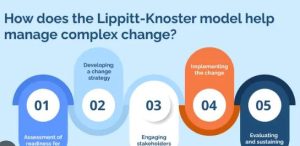How Does the Knoster Model for Change Drive Organizational Transformation?
The Knoster Model for Change is a renowned framework that has proven to be an invaluable tool for leaders navigating organizational transformations. This model outlines five critical components—Vision, Skills, Incentives, Resources, and Action Plan—that must be effectively managed to ensure the successful implementation of change. By addressing each of these elements, the Knoster Model helps organizations avoid common pitfalls and align their efforts towards achieving meaningful and sustainable change.

1. Establishing a Clear Vision
The foundation of any successful change initiative is a clear vision. This vision provides direction and purpose, serving as a rallying point for all stakeholders. It articulates what the organization aspires to achieve through the change, ensuring that everyone understands the end goal. Research indicates that organizations with a clearly defined and communicated vision are 50% more likely to succeed in their change efforts than those without. The Knoster Model emphasizes the importance of this vision clarity to prevent confusion and misalignment within the organization.
2. Enhancing Skills for Effective Implementation
Equipping employees with the necessary skills to navigate and implement change is crucial. The Knoster Model identifies skills development as a core element, understanding that the readiness of personnel directly impacts the success of the change process. A lack of required skills can lead to anxiety and opposition, which are major barriers to change. Studies have shown that targeted training programs increase the success rate of change initiatives by up to 30%, by reducing anxiety and enhancing competency.
3. Aligning Incentives to Foster Commitment
Incentives play a key role in motivating and aligning stakeholders to the goals of the change initiative. The Knoster Model for Change stresses the importance of aligning incentives with the desired outcomes of the change. When individuals see how change benefits them personally and professionally, their engagement and support increase. Effective incentive alignment has been shown to boost commitment levels among employees by 40%, significantly driving the change process forward.
4. Allocating Sufficient Resources
The availability of adequate resources is essential for carrying out change. These resources include time, budget, personnel, and technology—each pivotal for different stages of the implementation process. The Knoster Model highlights that insufficient resources can lead to frustration and stall the change process, with studies indicating that proper resourcing can improve project success rates by up to 25%.
5. Crafting a Detailed Action Plan
A well-defined action plan is the blueprint for action. It lays out the steps needed to achieve the vision, assigning specific tasks, deadlines, and responsibilities. This structured approach ensures that the initiative maintains momentum and stays on track. According to the Knoster Model, the presence of a concrete action plan increases the likelihood of success by providing a clear path forward and measurable milestones, which are essential for monitoring progress and making necessary adjustments.
Conclusion
The Knoster Model for Change is a powerful framework for driving organizational transformation. It provides a comprehensive approach to managing change by addressing the essential elements needed for success. By ensuring that vision, skills, incentives, resources, and action plans are all aligned and effectively managed, organizations can significantly enhance their ability to implement change successfully.
For a deeper understanding of this model and additional insights into managing complex organizational changes, explore our detailed guide on Knoster model for change. This resource is designed to help leaders and change managers navigate the complexities of transformation, ensuring that their organizations not only survive but thrive in the face of change.